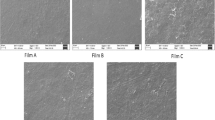Abstract
The blend films with gelatin and poly(vinyl alcohol) (PVA) were prepared by a solution casting method. The compatibility between gelatin and PVA in the blend films was investigated. The transmittance, Fourier-transform infrared spectroscopy (FTIR), x-ray diffraction (XRD), thermogravimetry analysis (TG), and differential scanning calorimetry (DSC) were employed to characterize the resultant blend films. According to optic result, the opacity of the blend film at the ratio of 20/80 (w/w, Gel to PVA) was the lowest, indicating the best compatibility between Gel and PVA at the ratio. The results of IR, XRD, DSC, and TG revealed an intensive interaction and good compatibility between them in the blend film at the ratio. The mechanical properties and solubility showed that PVA content in the blend films obviously affected the elongation at break and solubility. The mechanical properties and water resistance of gelatin film may be improved by the introduction of PVA.
Similar content being viewed by others
References
Bigi A, Cojazzi G, Panzavolta S, et al. Mechanical and Thermal Properties of Gelatin Films at Different Degrees of Glutaraldehyde Crosslinking[J]. Biomaterials, 2001, 22: 763–768
Rivero S, García MA, Pinotti A. Composite and bi-layer Films Based on Gelatin and Chitosan[J]. J. Food Eng., 2009, 90: 531–539
Pei Y, Zheng XJ, Tang KY. Natural Polymer Composites with Collagen and Gelatin as the Matrices: A Review[J]. Polym. Bull., 2010, (2):58–68
Chiou BS, Avena-Bustillos RJ, Bechtel PJ, et al. Cold Water Fish Gelatin Films: Effects of Cross-linking on Thermal, Mechanical, Barrier, and Biodegradation Properties[J]. Eur. Polym. J., 2008, 44: 3 748–3 753
Li Z, Cui K, Feng QL. Preparation and Characterization Analysis of Hydroxyapatite/Gelatin Composite[J]. J.Wuhan Univ. Technol.-Mater. Sci. Ed., 2005, 20: 226–228
Zhang YZ, Venugopal J, Huang ZM, et al. Crosslinking of the Electrospun Gelatin Nanofibers[J]. Polymer, 2006, 47: 2 911–2 917
Pranoto Y, Lee CM, Park HJ. Characterizations of Fish Gelatin Films Added with Gellan and k-Carrageenan[J]. LWT, 2007, 40: 766–774
Rivero S, GarcÍa MA, Pinotti A. Correlations between Structural, Barrier, Thermal and Mechanical Properties of Plasticized Gelatin Films[J]. Innove. Food Sci. Emerg., 2010, 11: 369–375
Bae HJ, Park HJ, Hong SI, et al. Effect of Clay Content, Homogenization RPM, pH, and Ultrasonication on Mechanical and Barrier Properties of Fish Gelatin/Montmorillonite Nanocomposite Films[J]. LWT-Food Sci. Technol., 2009, 42:1179–1186
Kaur I, Gautam N, Khanna ND. Synthesis and Characterization of Polypropylene-Grafted Gelatin[J]. J. Appl. Polym. Sci., 2010, 115: 1 226–1 236
Wan YZ, Wang YL, Cheng GX, et al. Properties of Carbon Fiber Reinforced Gelatin Composites[J]. Polym. Mater. Sci. Eng., 2001, 17(4): 86–89
Nagarajan M, Benjakul S, Prodpran T, et al. Properties of Film from Splendid Squid (Loligo formosana) Skin Gelatin with Various Extraction Temperatures[J]. Int. J. Biol. Macromol., 2012, 51: 489–496
Lopez-Caballero ME, Gomez-Guillen MC, Perez-Mateos M, et al. A Chitosan-Gelatin Blend as A Coating for Fish Patties[J]. Food Hydrocolloids, 2005, 19: 303–311
Arvanitoyannis IS, Nakayama A, Aiba S. Chitosan and Gelatin Based Edible Films: State Diagrams, Mechanical and Permeation Properties[J]. Carbohydr. Polym., 1998, 37: 371–382
Bae HJ, Cha DS, Whiteside WS, et al. Film and Pharmaceutical Hard Capsule Formation Properties of Mungbean, Waterchestnut, and Sweet Potato Starches[J]. Food Chem., 2008, 106: 96–105
Arvanitoyannis I, Psomiadou E, Nakayama A, et al. Edible Films Made from Gelatin, Soluble Starch and Polyols, Part 3[J]. Food Chem., 1997, 60(4): 593–604
Liu L, Kerry JF, Kerry JP. Application and Assessment of Extruded Edible Casings Manufactured from Pectin and Gelatin/Sodium Alginate Blends for Use with Breakfast Pork Sausage[J]. Meat Sci., 2007, 75: 196–202
Hernandez-Balada E, Taylor MM, Phillips JG, et al. Properties of Biopolymers Produced by Transglutaminase Treatment of Whey Protein Isolate and Gelatin[J]. Bioresource Technol., 2009, 100: 3 638–3 643
Carvalho RA, Maria TMC, Moraes ICF, et al. Study of Some Physical Properties of Biodegradable Films Based on Blends of Gelatin and Poly(vinyl alcohol) Using A Response-Surface Methodology[J]. Mater. Sci. Eng. C, 2009, 29: 485–491
Maria TMC, Carvalho RA, Sobral PJA, et al. The Effect of the Degree of Hydrolysis of the PVA and the Plasticizer Concentration on the Color, Opacity, and Thermal and Mechanical Properties of Films Based on PVA and Gelatin Blends[J]. J. Food Eng., 2008, 87: 191–199
Liu WG, Zhao XD, Yao KD. Morphology and Structure of Poly(LLactic Acid)/Gelatin Blend Membranes[J]. Polym.Mater. Sci. Eng., 2004, 20(2): 136–139
Zhang Q, Lu JL, Li Y, et al. Preparation and Characterization of Gelatin and Poly( L-Lactic Acid) Blending Films[J]. China Leather, 2011, 40(21):21–24
Xiao C, Lu Y, Jing Z, et al. Study on Physical Properties of Blend Films from Gelatin and Polyacrylamide Solutions[J]. J. Appl. Polym. Sci., 2002, 83: 949–955
Alexy P, Bakos D, Crkonova G, et al. Poly(Vinyl Alcohol)-Collagen Hydrolysate Thermoplastic Blends: II. Water Penetration and Biodegradability of Melt Extruded Films[J]. Polym. Test, 2003, 22: 811–818
Sionkowska A, Planecka A, Kozlowska J, et al. Photochemical Stability of Poly(Vinyl Alcohol) in the Presence of Collagen[J]. J. Polym. Degrad. Stab., 2009, 94: 383–388
Zhou Q, Li T, Li CY, et al. Biocompatibility of Implantable Electrodes Coated with PVA Films in the Brain of Rats: a Histological Evaluation[J]. J. Wuhan Univ. Technol. -Mater. Sci. Ed., 2009, 24(3): 393–396
Author information
Authors and Affiliations
Corresponding author
Additional information
Funded by the National Natural Science Foundation of China (Nos. 21076199, 51373158)
Rights and permissions
About this article
Cite this article
Gao, X., Tang, K., Liu, J. et al. Compatibility and properties of biodegradable blend films with gelatin and poly(vinyl alcohol). J. Wuhan Univ. Technol.-Mat. Sci. Edit. 29, 351–356 (2014). https://doi.org/10.1007/s11595-014-0920-9
Received:
Accepted:
Published:
Issue Date:
DOI: https://doi.org/10.1007/s11595-014-0920-9




